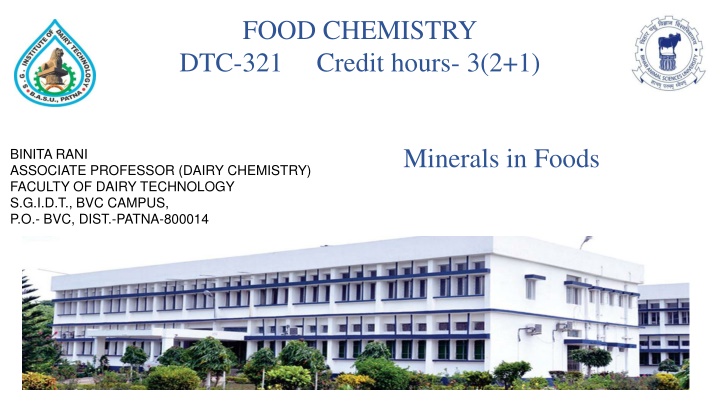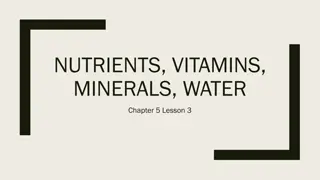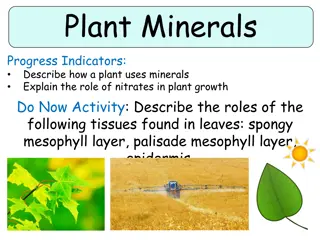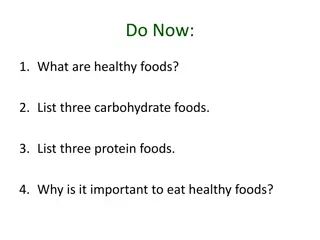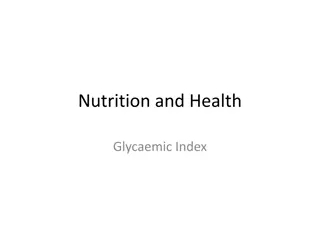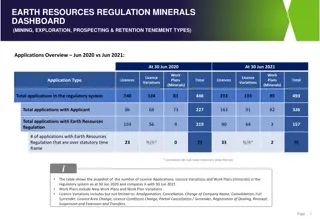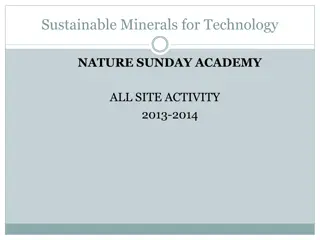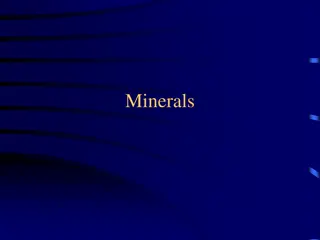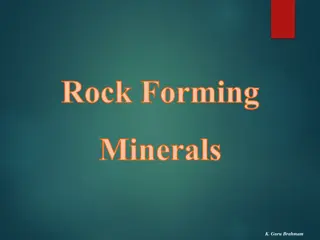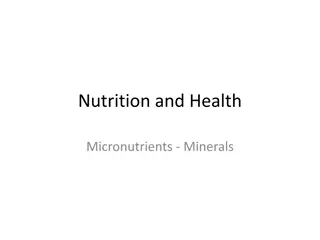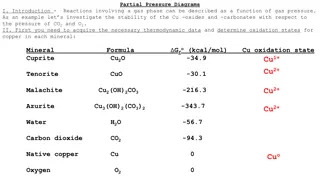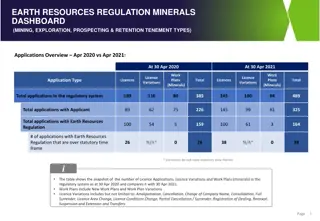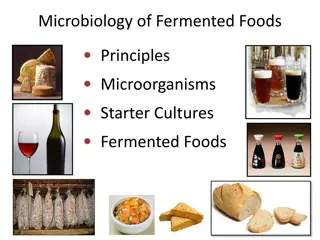The Importance of Minerals in Foods
Minerals play vital roles in food chemistry and human nutrition. There are main elements, trace elements, and ultra-trace elements present in foods that contribute to various physiological functions. Sodium, potassium, magnesium, and calcium are essential minerals with specific roles impacting human health. Proper intake and understanding of these minerals are crucial for maintaining a balanced diet and overall well-being.
Download Presentation

Please find below an Image/Link to download the presentation.
The content on the website is provided AS IS for your information and personal use only. It may not be sold, licensed, or shared on other websites without obtaining consent from the author.If you encounter any issues during the download, it is possible that the publisher has removed the file from their server.
You are allowed to download the files provided on this website for personal or commercial use, subject to the condition that they are used lawfully. All files are the property of their respective owners.
The content on the website is provided AS IS for your information and personal use only. It may not be sold, licensed, or shared on other websites without obtaining consent from the author.
E N D
Presentation Transcript
FOOD CHEMISTRY DTC-321 Credit hours- 3(2+1) Minerals in Foods BINITA RANI ASSOCIATE PROFESSOR (DAIRY CHEMISTRY) FACULTY OF DAIRY TECHNOLOGY S.G.I.D.T., BVC CAMPUS, P.O.- BVC, DIST.-PATNA-800014
Term mineralelements other than C, H, O, and N present in foods. No universally accepted definition of mineral Four non mineral elements (C, H, O, and N) present in organic molecules and water constitute 99% total number of atoms in living systems. Minerals remain as ash combustion of plant and animal tissues. Present relatively low conc in foods key functional roles .
Mineral supply depends intake bioavailability related to composition of food. Food constituents, e. g., amino acids, proteins, peptides, sugars, polysaccharides, phytin, lignin, and organic acids bind minerals enhance / inhibit absorption. affect texture of food. contribute food flavor. activate / inhibit enzyme-catalyzed and other reactions
Three classes: MAIN ELEMENTS: human beings in amounts > 50 mg/day e.g., Ca, Cl, K, Mg, Na, P, S . TRACE ELEMENTS: concentrations < 50 mg/day e.g.,Fe, F, Co, Cu, Cr, I, Zn, Se, Mn, Mo, Ni. ULTRA-TRACE ELEMENTS: vital elements e.g.,Al, As, B, Ba, Bi, Br, Cs, Cd, Ge, Hg, Li, Pb, Rb, Si, Sn, Sb, Sr, Ti, W.
NUTRITIONAL AND FUNCTIONAL ROLES Minerals have important nutritional and physiological functions . MAIN ELEMENTS Sodium: Sodium absorption is rapid. activates some enzymes, such as amylase. excessive intake hypertension. low intake of sodium a non-salty diet or by using diet salt (common salt substitutes).
Potassium: regulates osmotic pressure within the cell. involved in cell membrane transport. deficiency potassium-deficient foods, e.g., white bread, fat or oil. Potatoes and molasses sources.
Magnesium: constituent and activator many enzymes. associated conversion of energy-rich phosphate compounds Stabilizer membranes, and nucleic acids. plasma membranes, intracellular
Calcium: skeleton and in some body tissues. controls essential processes activity of brain cells and cell growth, blood clotting, (heartbeat). source milk and milk products, fruit and vegetables, cereal products, meat, fish and eggs. muscle contraction
Chloride: serves as counter ion for sodium in extracellular fluid and for hydrogen ions in gastric juice. absorption is as rapid as its excretion urine. Phosphorus: essential nutrient. in the form of phosphate, free or bound as an ester or present as an anhydride, plays imp role metabolism
TRACE ELEMENTS Iron: essential ingredient of daily diet present hemoglobin (blood) and myoglobin (muscle tissue) pigments. present enzymes (peroxidase, catalase, hydroxylases and flavine enzymes) Two food processing problems iron fortification : 1. increased probability oxidation 2. wheat flour decreased baking quality. undesirable element food processing catalyzes oxidation of fat / oil, increases turbidity of wine, supports growth of iron-requiring bacteria.
Copper: component of oxidoreductase enzymes (amine oxidase, cytochrome oxidase, superoxide dismutase, tyrosinase, uricase ). less desirable than iron food processing and storage catalyzes many unwanted reactions. Cu2+-Ions are taste bearing. Threshold value 2.4 3.8mg/l was determined with aqueous solutions of CuSO4 or CuCl2.
Zinc: component enzymes (e.g., alcohol dehydrogenase, carbonic anhydrase, carboxypeptidases A and B, glutamate dehydrogenase, lactate dehydrogenase and malate dehydrogenase,,). Other enzymes, e.g., alkaline phosphatase, dipeptidases, enolase and lecithinase are activated by zinc. deficiency in animals serious disorders. high zinc intake toxic.
Manganese: metal activator for pyruvate carboxylase . activates various enzymes alkaline phosphatase, amino peptidase, arginase, lecithinase or enolase. even in higher amounts relatively nontoxic.
Cobalt: Essential element Vitamin B12 contains cobalt as its central atom. Its requirement met by normal nutrition.
Chromium: important utilization of glucose. activates enzyme phosphoglucomutase and increases activity of insulin deficiency a decrease in glucose tolerance.
Selenium: vary greatly varying content of selenium in the soil depending on the region. antioxidant and can enhance tocopherol activity. Enzyme glutathione peroxidase contains selenium.
Molybdenum: component of aldehyde oxidase and xanthine oxidase. bacterial nitrate reductase involved in meat curing and pickling processes contains molybdenum
Nickel: activator of enzymes, e.g., alkaline phosphatase and oxaloacetate decarboxylase, which can also be activated by other divalent metal ions. enhances insulin activity.
Fluorine: Addition drinking water 0.5 1.5 ppm fluorine in the form of NaF inhibits tooth decay. beneficial effect retarding solubilization of tooth enamel and inhibiting the enzymes involved development of caries. Toxic effects at a level of 2 ppm. beneficial effects of fluoridating drinking water disputed by some and controversial topic of mineral nutrition.
Iodine: absorption as iodide . utilized in thyroid gland biosynthesis of hormone thyroxine (tetraiodothyronine) and its less iodized form, triiodothyronine. deficiency enlargement of the thyroid gland (iodine-deficiency induced goiter). most food little iodine. Good sources milk, eggs and seafood. Drinking water little iodine supply. To avoid deficiency diseases iodization of common salt is done in which potassium iodate, with 100 g iodine added to 1 10 g NaCl.. Higher amounts of iodine toxic.
ULTRA-TRACE ELEMENTS Tin: natural level of tin in food very low. can be increased foods canned in tinplate cans. Very acidic foods dissolve substantial amounts of tin. concentration of tin in pineapple and grapefruit juice transported in poorly tin plated cans 2 g/l. tin content of foods in tinplate cans generally below 50mg/kg and should not exceed 250 mg/kg.
Aluminum: resorbed in only negligible amounts by gastrointestinal tract. largest portion is eliminated in feces. not secreted in milk.
Boron: essential nutrient. promotes bone formation by interaction with calcium, magnesium and vitamin D. involved in hydroxylation of steroids, e.g., in the synthesis testosterone. sources include wine and water.
Silicon: rapidly absorbed as soluble silicic acid. source is cereal products. promotes growth and thus has a biological role. toxicity of silicic acid is apparent only at concentrations 100 mg/kg.
Arsenic: main source is fish. metabolic role is not yet understood. appears to be involved in the metabolism of methionine. Choline can be replaced by arseno choline in some of its functions.
MINERAL CONTENT OF EGGS , CEREALS AND CEREAL PRODUCTS, FRUITS AND VEGETABLES
NUTRITIONAL AND FUNCTIONAL ROLE OF MINERALS AND MINERAL SALTS IN FOODS
